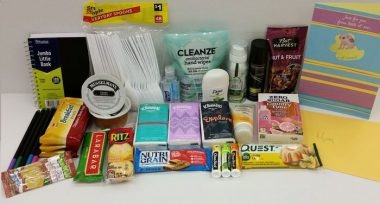5 Things Hospitalized Patients and Their Caregivers Want

Spoiler alert: It is not flowers and balloons.
A couple of weeks into our stint in the critical care unit due to my husband’s aHUS, a surprise visit from my sister showed me the value of little things and great thoughtfulness. While my husband, Ronald, struggled to simply live, I hadn’t realized how many simple elements were missing from my life. Then she showed up with lotion, socks, and underwear.
Care packages
A true care package should just show you care. There is no need or use for anything expensive or irreplaceable. It should consist of practical stuff for the recipient to use, lose, or share. Most of these are available at your local drug, dollar, or convenience store — all places suddenly beyond the reach of the hospitalized, which makes them seem exotic and luxurious.
1. Toiletries
Generic hospital supplies address the minimum of bodily maintenance. The gifts you choose may not be their usual brand, but anything that does not smell like disinfectant will be welcome. Travel sizes are cheap and don’t take up much space on the tiny bathroom shelf — if there is one.
Deodorant, lotion, and lip balm are daily defenses against the stale, dry air of indoor spaces. Pocket packs of tissues will ward off attacks of sneezes, sniffles, and tears wherever and whenever they strike.
Secret weapon: dry shampoo for days without showers.
2. Nibbles and bits
Convenience food does not have to be junk food. Look for nutritious and tasty tidbits that don’t need to be refrigerated or heated. If providing these for a patient, make sure the nurses are aware and approve. Caregivers, however, will eat anything.
Single serving and individually wrapped are key qualities for food stockpiles in the hospital. Packets of dried fruit or nuts, applesauce and other fruit cups, energy bars, jerky, and crackers with cheese or peanut butter are all sensible snacks. Hard candies, as well as flavored powder to add to water, provide relief from the common prescription side effect of dry mouth.
Don’t forget a package of picnic spoons and the plastic shopping bags the treats came in, to recycle as trash bags for all of those wrappers.

Lesson learned: A care package Annie recently assembled for her mother. (Photo by Annie Dixon)
3. Comfortable, clean clothes
Fashion goals quickly give way to reduced ambitions of modesty and cleanliness during hospital stays. Patients are barely draped in skimpy gowns with few closures. Caregivers rinse out pieces of their tiny trousseau in the sink each night, hoping they will be dry for reuse by morning.
Opening a three-pack of T-shirts, underwear, or socks feels like Christmas when one is confined to a single room without a closet or a washing machine. Likewise, a robe or sweatshirt from the clearance rack at the discount department store feels like a new runway outfit in the long institutional corridors.
Bonus: pockets for the tissues and lip balm.
4. Desk accessories
Of course, there is no desk in a hospital room. Thus, there is no drawer cluttered with the little tools we habitually reach for throughout the day. Instead, hospital inhabitants resort to writing notes to self on their hands and opening individually wrapped treats with their teeth.
A notebook and pen help to keep track of concerns and questions that would otherwise be forgotten due to sleep deprivation and distractions. Tape or poster putty enables those notes to be hung on the door or over the patient’s bed. A pair of children’s scissors can cut snack wrappers, condiment packets, and clothing tags without endangering anyone’s teeth.
Splurge: a throwaway phone with preloaded minutes for long-distance calls.
5. Mind games
Life on a hospital ward can alternate between intense and boring. And those boring times can seem eternal and empty. Left alone, minds wander, and we tend to fill those long hours with worry.
Books and magazines are full of other things to focus on, whether fact or fiction, tomes or tabloids. Crossword puzzles, coloring books, and card decks offer solitary or competitive diversions for patients and their companions.
Best choices: a collection of short stories or essays, a daily devotional, or the tackiest rag in the checkout aisle — all well suited to the short attention span of convalescence.
The gift that keeps on giving
People want to help. They say, “Let me know if I can do anything,” because they have no idea what to do. Patients and caregivers can help them by asking for small, specific items that will make a big difference in reality and attitude.
Thoughtful trinkets may even be treasured in the future. A staple of my summer wardrobe is a plain white short-sleeved shirt my sister brought me. It brings back memories of her kindness that are as warm and fuzzy as any stuffed animal from the hospital gift shop.
***
Note: aHUS News is strictly a news and information website about the disease. It does not provide medical advice, diagnosis, or treatment. This content is not intended to be a substitute for professional medical advice, diagnosis, or treatment. Always seek the advice of your physician or other qualified health provider with any questions you may have regarding a medical condition. Never disregard professional medical advice or delay in seeking it because of something you have read on this website. The opinions expressed in this column are not those of aHUS News or its parent company, Bionews, and are intended to spark discussion about issues pertaining to aHUS.








Leave a comment
Fill in the required fields to post. Your email address will not be published.